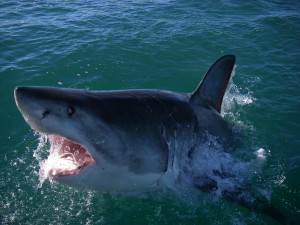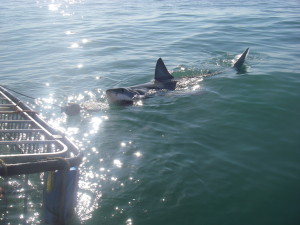Marine Life & Conservation
Decimation of the Great White Shark

The Great White Shark has survived an array of disasters during the last few million years, including several ice ages, which saw the extinction of many animals. Yet it is unlikely to survive its biggest threat to date… us. Some shark specialists believe they could be wiped out within the next decade. With the alarming decline in their numbers, this might be the last chance for people to see these incredible creatures without having to visit a museum.
Since the Great White Shark was listed on CITES Appendix II* at the 13th meeting of the Conference of Parties of CITES in Bankok, 2004, we have still seen massive drop in their numbers. Through research conducted by White Shark Africa’s students aboard vessels, we have seen the average number of individual Great White Shark sightings per boat trip drop from 4.56, to 2.75** and another recent study has discovered that only 219 Great White Sharks now exist in the waters off California***.
The World Wildlife Fund (WWF) seem to have made an accurate prediction in September 2004 when they listed the Great White Shark among the ten species of animals and trees it believes will most likely become extinct. Shark finning, trophy hunting, the fishing trade, beach protection nets and ocean pollution all play a part in the decimation of these top level predators. Females do not reach reproductive age until at least 15 years of age, have a low reproductive rate with very small litters, and therefore cannot reproduce at the same rate as their decline.
Despite their ferocious portrayal, the Great White Shark is a sociable character, often gentle and inquisitive, and even playful at times. They contribute massively to our ecosystems and with their deteriorating numbers we will see a direct impact to the entire planet. These top predators keep the marine ecosystems in balance with the prey they eat and if it is not held in check, the food source for several species of marine life disappears including microorganisms, which are essential for sustaining life.
Christo Kruger, Director of White Shark Africa has worked with Great White Sharks for over 12 years though his passion stems back even longer and he is extremely concerned for their survival. “I’ve seen a dramatic drop in the number of sharks along the Western Cape coastline during my time working with them,” says Christo. “If things don’t change now, we will be responsible for the destruction of a species, though it may already be too late to change their future. I believe that we will be looking at the world’s oceans in 10 years time and it will almost be devoid of life.”
Several ways to get involved
- Join one of White Shark Africa’s programs and learn more about these incredible creatures while viewing them in their natural environment.
- Book a place on a viewing and cage diving trip, helping to ensure that the Great White Shark is worth more alive than dead.
- Write to IUCN (International Union for Conservation of Nature and Natural Resources) to enforce the need for Great Whites to be relisted on their red list as ‘critically endangered’. They are currently classified as ‘vulnerable’.
- Write to CITES to ask them to propose to move Great White Sharks to Appendix I*.
[youtube id=”GwN9ovmDg9g” width=”100%” height=”400px”]
To find out more, visit http://www.whitesharkafrica.com
- * CITES (Convention on International Trade in Endangered Species of Wild Fauna and Flora) Appendix II includes species not necessarily threatened with extinction, but in which trade must be controlled in order to avoid utilisation incompatible with their survival. Appendix I lists species that are the most endangered.
- ** Research comparison of data from January to June 2010 with January to June 2011 and average number of individual sightings calculated per trip.
- *** Study conducted by Royal Society Biology Letters on Great White Sharks off Central California between 2006 and 2008.
Blogs
Invitation from The Ocean Cleanup for San Francisco port call

6 years ago, The Ocean Cleanup set sail for the Great Pacific Garbage Patch with one goal: to develop the technology to be able to relegate the patch to the history books. On 6 September 2024, The Ocean Cleanup fleet returns to San Francisco bringing with it System 03 to announce the next phase of the cleanup of the Great Pacific Garbage Patch and to offer you a chance to view our cleanup system up-close and personal.
We look forward to seeing you there.
To confirm your presence, please RSVP to press@theoceancleanup.com
PROGRAM
Join The Ocean Cleanup as our two iconic ships and the extraction System 03 return to San Francisco, 6 years and over 100 extractions after we set sail, to create and validate the technology needed to rid the oceans of plastic.
Our founder and CEO, Boyan Slat, will announce the next steps for the cleanup of the Great Pacific Garbage Patch. Giving you a chance to view our cleanup system and the plastic extracted.
Hear important news on what’s next in the mission of The Ocean Cleanup as it seeks to make its mission of ridding the world’s oceans of plastic an achievable and realistic goal.
Interviews and vessel tours are available on request.
PRACTICALITIES
Date: September 6, 2024
Press conference: 12 pm (noon)
Location: The Exploratorium (Google Maps)
Pier 15 (Embarcadero at Green Street), San Francisco, CA
Parking: Visit The Exploratorium’s website for details.
RSVP: press@theoceancleanup.com
Video & photo material from several viewing spots around the bay
We look forward to seeing you there!
ABOUT THE OCEAN CLEANUP
The Ocean Cleanup is an international non-profit that develops and scales technologies to rid the world’s oceans of plastic. They aim to achieve this goal through a dual strategy: intercepting in rivers to stop the flow and cleaning up what has already accumulated in the ocean. For the latter, The Ocean Cleanup develops and deploys large-scale systems to efficiently concentrate the plastic for periodic removal. This plastic is tracked and traced to certify claims of origin when recycling it into new products. To curb the tide via rivers, The Ocean Cleanup has developed Interceptor™ Solutions to halt and extract riverine plastic before it reaches the ocean. As of June 2024, the non-profit has collected over 12 million kilograms (26.4 million pounds) of plastic from aquatic ecosystems around the world. Founded in 2013 by Boyan Slat, The Ocean Cleanup now employs a broadly multi-disciplined team of approximately 140. The foundation is headquartered in Rotterdam, the Netherlands, and opened its first regional office in Kuala Lumpur, Malaysia, in 2023.
Find out more about The Ocean Cleanup at www.theoceancleanup.com.
Marine Life & Conservation
SHARK MONTH ARRIVES AT ROYAL WILLIAM YARD, PLYMOUTH

A shark has been spotted approaching Royal William Yard in Plymouth, much to the surprise of swimmers, paddleboarders and onlookers.
With its distinctive dorsal fin cutting through the water, the sizeable shark swam along the coastline, before turning to head inland towards Firestone Arch at Royal William Yard. The appearance drew a crowd, who were captivated for more than an hour by the unusual sight – and it was all caught on video.
The shark is one of many expected sightings at Royal William Yard over the coming weeks… because today marks the start of Shark Month!
In reality, the ‘shark’ spotted along the Plymouth shoreline was actually a custom-made model, created by the team at Royal William Yard and sailed underwater by Caroline Robertson‑Brown from the Shark Trust, who donned scuba diving gear for the occasion.
The stunt took place to launch Shark Month in style and draw attention to the work of the leading international conservation charity, which is based in Britain’s Ocean City. Spectators were reassured that the water was safe and many entered into the spirit of the performance, swimming or sailing alongside the shark.
Shark Month will take place across Royal William Yard throughout July and will feature an extravaganza of art, entertainment and advocacy for everyone to enjoy. The packed programme of events starts with an art exhibition and ends with a trip on paddleboards with shark experts – with everything from a shark quiz to a Jaws screening in between.
Paul Cox, CEO of the Shark Trust, said: “There are often assumptions and misconceptions when it comes to sharks. This was certainly the case with the shark spotted at Royal William Yard! While the British coastline is home to many species of shark, this was not one of them. However, we’re thrilled it caught people’s attention, because seeing a shark is a special and memorable moment. That is precisely why we want to celebrate these incredible creatures, highlight the need for conservation, and ask for help to safeguard their future.”
For more information about Shark Month at Royal William Yard, visit the Shark Trust Website.
Images and video: Jay Stone
-

 Blogs2 months ago
Blogs2 months agoDiving With… Nico, Ocean Earth Travels, Indonesia
-

 News1 month ago
News1 month agoMurex Bangka Announce New Oceanfront Cottages & Beachfront Dining
-

 Blogs2 months ago
Blogs2 months agoA new idea in freediving from RAID
-

 Marine Life & Conservation1 month ago
Marine Life & Conservation1 month agoIceland issue millionaire whale hunter a licence to murder 128 vulnerable fin whales
-

 Marine Life & Conservation2 months ago
Marine Life & Conservation2 months agoThe Shark Trust Great Shark Snapshot is back
-

 News3 months ago
News3 months agoCharting New Waters; NovoScuba Goes Global with the Launch of their Revolutionary Dive Training Agency!
-

 Gear News1 month ago
Gear News1 month agoNew Suunto Ocean – a dive computer and GPS sports watch in one for adventures below and above the surface
-

 Marine Life & Conservation Blogs2 months ago
Marine Life & Conservation Blogs2 months agoBook Review: Plankton







